| METAMORPHIC ORIGIN: OBSERVED AND INFERRED
|
| OBSERVATIONS |
The claim of metamorphic origin for a rock is strongest in those cases where: - the rock has clearly been subjected to extreme conditions, and
- the rock appears altered compared to equivalent rocks that have clearly not been subjected to the same extreme conditions.
| |
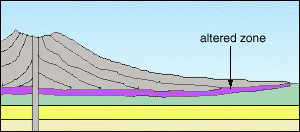 | The diagram on the left is a cross section through a volcanic cone resting on a series of horizontal sedimentary rocks. Within the purple zone, the uppermost sedimentary rock layer appears in an altered state. The next diagram is a detail showing an exposure of the topmost lava flow and the sedimentary rocks underneath. |
 | Notice the upward gradational changes in the sedimentary layer as the lava flows is approached. Also notice the inclusion of a chunk of the sedimentary layer within the lava flows. (As the lava flowed over the landscape, it picked up and engulfed eroded, loose fragments of the underlying bedrock.) The inclusion is similar in its characteristics to the most altered part of the uppermost sedimentary layer.
The argument for metamorphic origin for the rock shown in purple is strong because of its undoubted association with igneous activity (volcanic eruption) and high temperature. |
| WORKING FROM THE KNOWN TO THE UNKNOWN |
Igneous origin has been established to the geologists' satisfaction for some intrusive rock bodies by tracing textural and mineralogic similarities between the intrusive rocks and extrusive (volcanic) rocks. 
In cases where such arguments for igneous origin for an intrusive are convincing, the criteria for metamorphic origin for adjacent rocks may be considered met. That is, an adjacent rock may be interpreted as metamorphic because it appears that: - the rock has been subjected to extreme conditions (as may be inferred by its proximity to the intrusive body), and
- the rock appears altered compared to equivalent rocks that have clearly not been subjected to the same extreme conditions (as may be inferred by their distance from the intrusive body).
| |
 | In the diagram to the left, the pink areas represent observed and inferred igneous rocks. The intensity of metamorphism displayed by the surrounding rocks is indicated by dark brown (intensely altered) fading to light brown (unaltered). Rocks in the vicinity of boundary area B and inclusion C are shown in the following three photographs. |
 | Boundary area: Intrusive igneous rock (pink) has invaded intensely metamorphosed rock (black). Note how the black rock body labeled 'X' is actually detached and surrounded by the pink, igneous rock. Before the melt that gave rise to the pink rock solidified, a detached body such as 'X' could sink into the magma, as did the inclusions shown in the next photograph. |
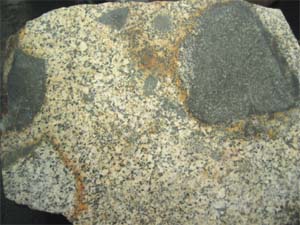 | Inclusions: Intensely altered inclusions (dark grey) are surrounded by igneous rock (speckled pink and black). |
| The following series of photographs shows changes encountered in rocks invaded by a large intrusive body as the intrusive is approached. |
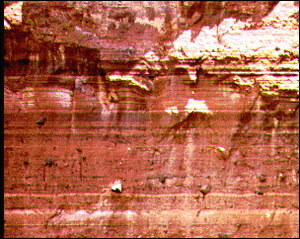 | Remote from the intrusive: Horizontally layered, clastic sedimentary rocks. |
 | Closer to the intrusive: Folded clastic sedimentary rocks. |
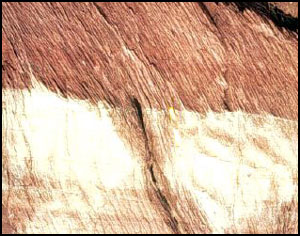 | Approaching the intrusive: Development of slaty cleavage. |
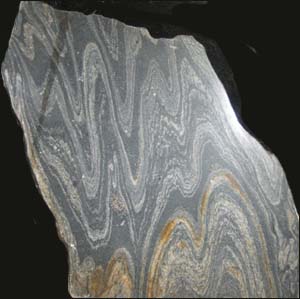 | Close to the intrusive: Coarse-grained crystalline rock with tightly folded layers. |
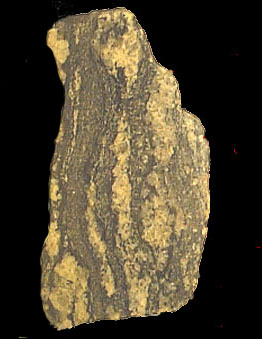 | Very close to the intrusive: Coarse-grained crystalline rock with discontinuous layers. |
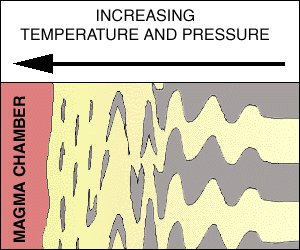 | In this diagram, the structural changes noted above are shown schematically. Note the direction of increasing metamorphism (increasing temperature and pressure). |
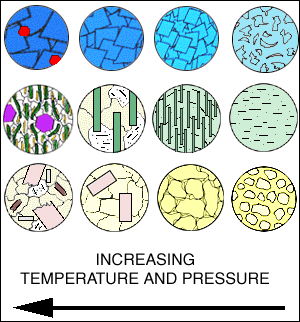 | Here, a series of micro-textural drawings show the small-scale changes encountered with increasing proximity to the intrusive body. Each horizontal row of circles shows the changes in a single layer of originally uniform rock. The rock's unaltered character is shown on the extreme right; its most altered equivalent is shown on the extreme left.
Note changes in mineralogy that occur from right to left in each row, indicated by the introduction of new colors. |
Use the link to review common mineral assemblages found in rocks metamorphosed due to their proximity to igneous rocks: 
|
 Task 1: Describe one structural change that accompanies increasing metamorphism in the vicinity of a large intrusive igneous body. Task 1: Describe one structural change that accompanies increasing metamorphism in the vicinity of a large intrusive igneous body.
 Task 2: Describe two textural changes that accompany increasing metamorphism in the vicinity of a large intrusive igneous body. Task 2: Describe two textural changes that accompany increasing metamorphism in the vicinity of a large intrusive igneous body.
|
|
| CONCLUSIONS & SPECULATIONS |
| Using the principle of 'Working From the Known to the Unknown', geologists with great confidence have come to recognize the signs of metamorphism in rocks associated with extrusive igneous activity (by observation) and intrusive igneous activity (by inference). Upon encountering similar structural, textural and mineralogic signs in rocks that are not clearly associated with igneous activity, they nevertheless feel confident in identifying them as metamorphic: the product of elevated temperatures and pressures and migrating chemical components.
Continuing field, laboratory and theoretical investigations allow geologists to pin down ranges of temperatures and pressures that give rise to particular mineral associations and to infer where, within the earth, such conditions are likely to prevail. |
Indeed, taking a broader view, the generation of melts that solidify to form igneous rocks, and large-scale metamorphism, whether or not associated with large igneous bodies may all find a common origin in plate tectonic processes. As plates converge and diverge, temperatures and pressures change inexorably, and rock materials respond accordingly, altering and/or melting. 
Three of many possible plate tectonics scenarios that feature igneous and/or metamorphic processes on a grand scale will be considered.
|
|
| Scenario 1: |
 | There are many instances where vast expanses of metamorphic rocks are exposed with no associated large igneous bodies. To what do these metamorphic rocks owe their origin? Elevated temperatures and pressures not attributable to igneous activity may be due to rock materials being compressed and pushed down to hotter regions. Such processes occur at convergent plate boundaries. Here, a wedge of sediment caught between colliding plates is severely deformed and subjected to rising temperatures. The rocks within the deeper parts of the wedge are metamorphosed. Note that no significant melting occurs within the wedge. |
| Scenario 2: |
 |
In some instances where a wedge of sediment is caught between colliding plates, temperatures and pressures develop that cause certain rocks to metamorphose profoundly, while causing intermixed and adjacent rocks of different composition to actually melt, resulting in the formation of local magma chambers (see pink dots in sediment wedge). The next diagram is an enlargment of the region in which such 'partial melting' has taken place. |
 | In this diagram, the bright yellow layers represent materials that melt more easily than the materials in the darker colored layers. The temperature and pressure are such that parts of the yellow layers melt while the rest of the region metamophoses but does not melt. There is no distinct zone of metamorphism around the melts because the entire region is undergoing metamorphism, with the melts being a local, more extreme response to the prevailing conditions. That is, the melts are the result of the general change in conditions; they are not the cause of the change in conditions. |
 | The bodies of melt (magma) gradually migrate upward (due to their having a lower density than the surrounding rocks) into regions of lower temperature and pressure where the rocks have been less profoundly metamorphosed. Here, the relatively cold rocks invaded by the magma bodies are altered by heat and fluids emanating from the melts. Narrow zones of intense metamorphism form around the peripheries of the intrusives (shown in dark blue).
|
| Scenario 3: |
 | Where an oceanic plate is subducted underneath a continent-bearing plate, melts generated above the descending plate will rise and penetrate the continent, forming huge pools of magma (shown in pink). Emplacement of this magma deforms and metamorphoses the rock that it intrudes over vast regions (shown in transparent purple), and swells the continental crust. Some of the magma reaches the surface to form volcanoes (note grey ash plumes).
|
 Question 1: Consider these two statements: (a) In some circumstances, melting is a by-product of changes that cause metamorphism. (b) In some circumstances, the presence of a melt causes the changes that result in metamorphism. Explain each statement. Question 1: Consider these two statements: (a) In some circumstances, melting is a by-product of changes that cause metamorphism. (b) In some circumstances, the presence of a melt causes the changes that result in metamorphism. Explain each statement.
|
|
To check your answers and get additional hints and information, click on the link. |